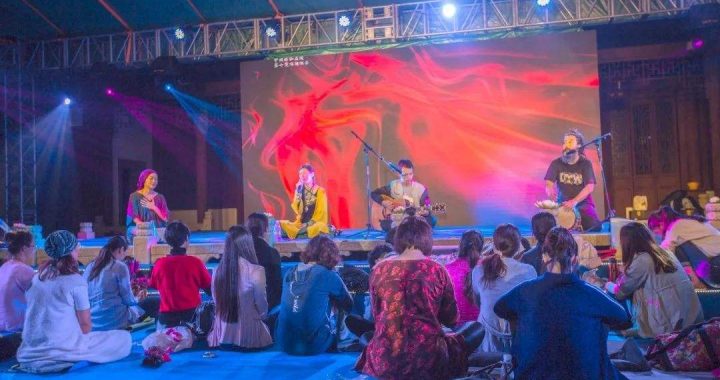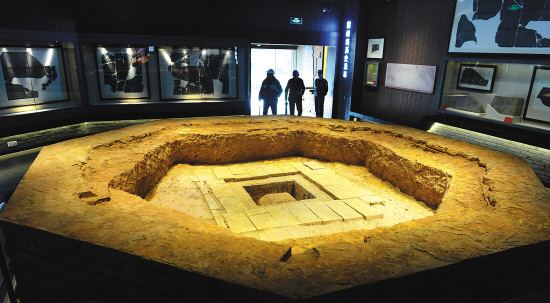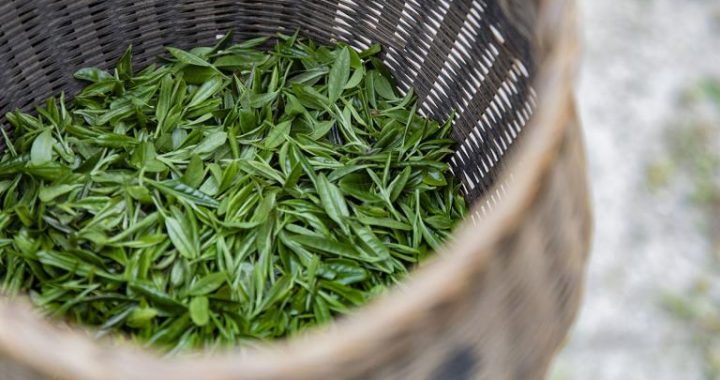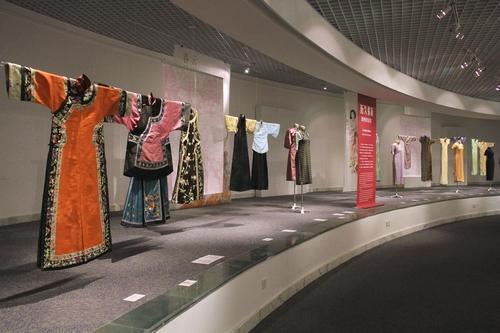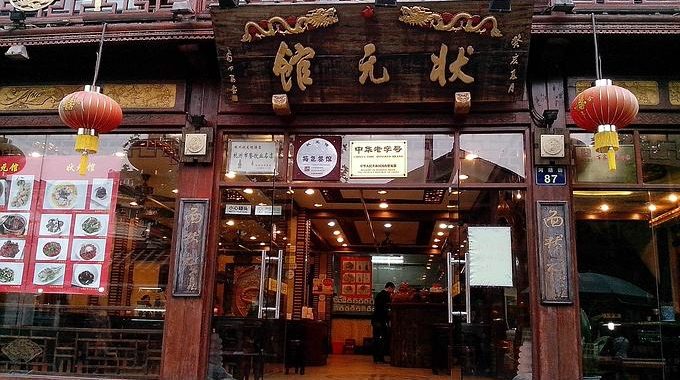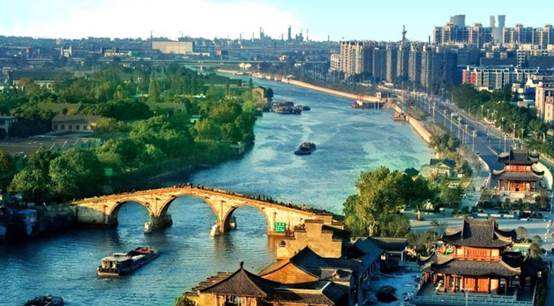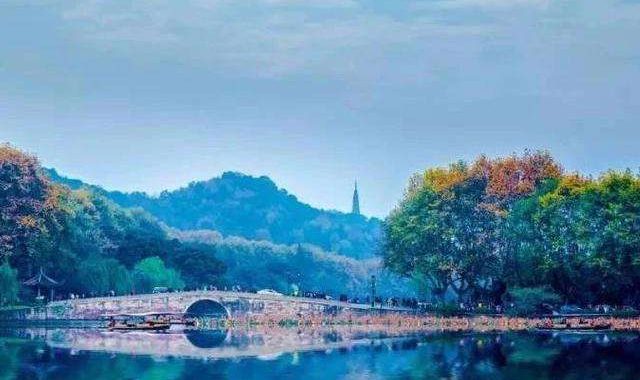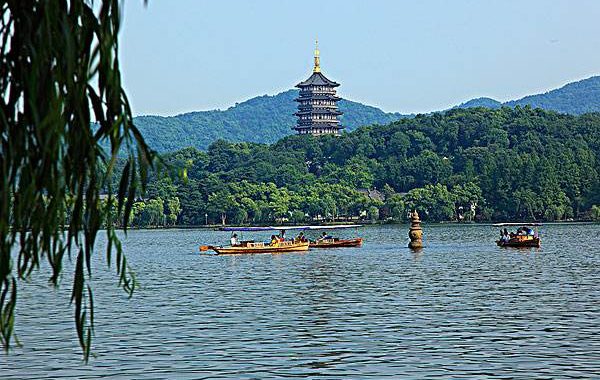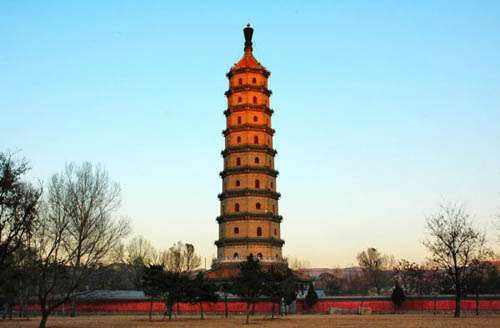Hangzhou’s Protector
9 min readWhile West Lake rose,so too did the people who lived around it-notably as Hangzhou became a Chinese capital.Although the Tang Dynasty collapsed in 907,Hangzhou kept itsriches and strategic position intact.A new political power known as the Wuyue Kingdom rose with Hangzhou as its capital.This general pocket of time in China is referred to as th e“Five Dynasties and Ten Kingdoms Period”,an era of competing states that saw five dynasties flash across central China while more than a dozen popped up in southern China.
Many would rule independently until the Song Dynasty unified them in 960.
Descending from a line of Tang military officers,the Qian family first formed and ruled the Wuyue.Indeed,the Qian family’s prowess defines Hangzhou to this day,with their own family museum,King Qian’s Temple,along the eastern banks of West Lake in the Orioles Singing in the Willows scenic area.
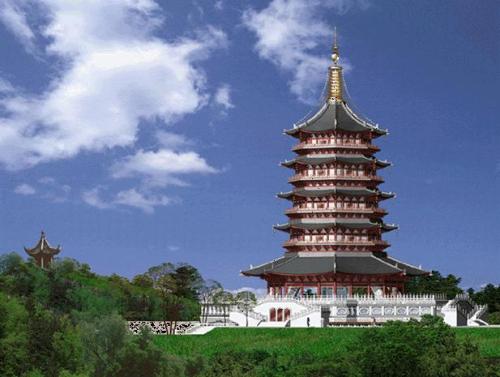
A portmanteau for the Wu and Yue kingdoms during the Spring and Autumn Period,this Wuyue Kingdom extended from modern day Shanghai down to Fujian Province.Its capital,Hangzhou,was called Qiantang and became a fountain for regional commerce.Under the reign of its first king Qian Liu,Buddhism was heavily patronized,as were sea-trade and infrastructure.The West Lake was dredged and the Qiantang River given seawalls,and the kingdom’s maritime prowess allowed it to develop formal relations with Japan in 935,as well as keep ties with northern Chinese kingdoms and Korea.Indeed,such was Hangzhou’s reputation for Chan(Zen)Buddhism that monks from Japan and Korea flocked to it to study-with Wuyue monks reciprocating with visits to the high Heian court at Kyoto,Japan,and Silla Dynasty in Gyeongju,Korea.The Wuyue left two iconic towers on West Lake’s landscape.On Baoshi Hill,they built the seven-storey Baochu Pagoda,erected in homage of the safe return of King Qian Chu after he was summoned to the newly established Song court at Kaifeng at the northern terminus of the Grand Canal.
The original Baochu, or”Protect Chu”, tower was destroyed and rebuilt a few times through history, most recently in 1933. The modern one is slightly shorter than the original.
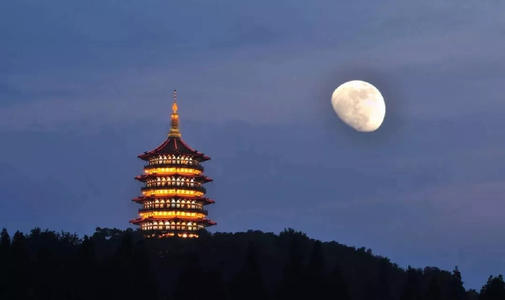
Still, it stands above the north shore of West Lake like a finger pointing to its glorious Qian kings in the heavens above, including the last king of Wuyue, King Qian Chu. He was among the last holdouts that finally gave in to the Song armies or face certain doom.
Despite coming to power in 960, it would take 18 years for the Song to totally subdue King Qian Chu. As a last stand of sorts, he built Leifeng Pagoda in honor of his newborn son in 975 on the southern shores of West Lake. Octagonal and proud at seven storeys, Leifeng Pagoda would come to define the classical skyline of the city.
The iconic pagoda took two years to complete, just as a new Song emperor came to power and named King Qian Chu,”Chancellor, Chief Secretary, and Commander of All Horses and Soldiers under Heaven.”This title essentially subjugated him, though, and he was recalled to Kaifeng with his court of 3,000. Despite his noble deeds, the former king’ luck would soon run out. Merely a decade after bowing to the Song, he died in 988 after a birthday celebration, at which he entertained guests sent from the royal court to congratulate him.
His sons would go on to guide Hangzhou into its greatest years under the Song. Little could King Qian Chu have imagined that, over 140 years after his death, his beloved city of Hangzhou would become the capital of the Song, by then known as the Southern Song Dynasty. Through its advanced technology, culture, and communication, his later descendents would manage a city and empire that would alter the course of world history.
Leiteng
Hangzhou,like Rome,wasn’t built in a day.But Leifeng Pagoda was erected “within a moment of a finger snap”-so proclaims a Buddhist votive inscription from over 2,000 years ago when the pagoda was first built.Archaeologists found inside it one ofthe hollowed out sacred Buddhist bricks that originally formed this architectural treasure that towers over the southern banks of West Lake.
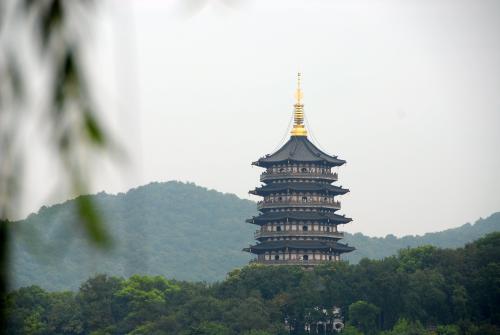
These sacred bricks rest in ruins under the foundations of the current Leifeng Pagoda,which was reconstructed and brought back to its former glory in 2002.
To ascend this octagonal tower of ancient lore,one can climb steps or take an escalator-the latter for the convenience of handicapped,elderly,and adults carrying babies.Once up the hill,the mystery of this pagoda starts to unfold.
This was a fortress for sacred Buddhist learning and power.Remaining ramparts of its excavated base attest to its strength as a foreboding specimen of time-as its master King Qian Chu might have willed it.
The last ruler of the coastal kingdom of Wuyue in the tenth century,Qian was a devoted Buddhist.Countless pagodas and temples were built under the court’s patronage in its capital city Qiantang,present day Hangzhou,including the Leifeng Pagoda.One tale of its origin states that King Qian built it to celebrate the birth of his prince by Consort Huang,hence the pagoda’s old name,Huangfei Pagoda(Consort Huang’s Pagoda).This noble lady’s family name happened to have the same pronunciation as the word“royal”so people began to call it”The Royal Consort’s Pagoda”,which was technically still correct.Today,you can find these three words inscribed on a plaque at the exit of the Leifeng Pagoda,reminding visitors of its early history.
Looking at the dusty bricks in the spacious rotunda,one can be reminded of the distantpast-and that early travelers here during the Song considered the pagoda too new to be noteworthy,considering the ancient temples and shrines nestled in the surrounding hills.It would take several more centuries before it would enter the permanent imagination of Chinese poets and literati.
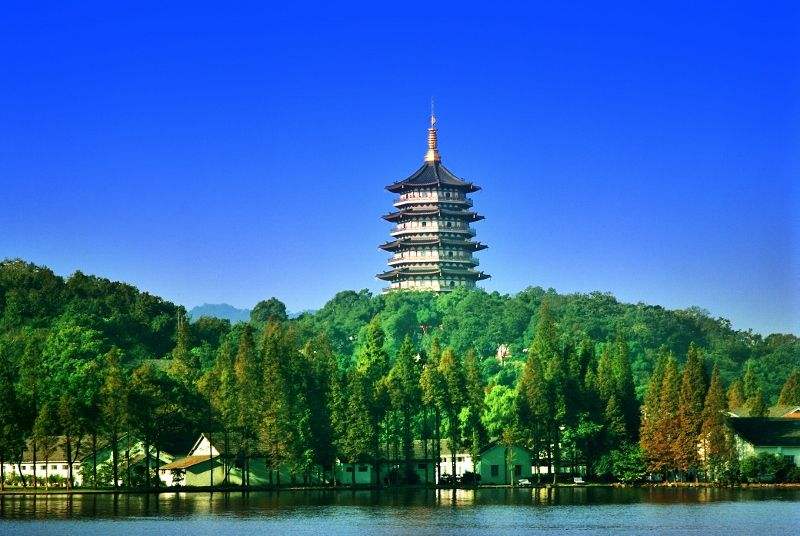
The pagoda’s upper floors host bricks inlaid with gold characters,trinket shops,and video presentations of archaeological undertakings.
Above this floor is the entrance to the glass elevator that propels visitors skyward into the modern pagoda.One feels the commanding views King Qian must have marveled at over a millennium ago.Sublime views wait in every direction.To the south is Jingci Temple abutted by lush hills;to the north is the immense West Lake itself,deep and green.Far in the distance is Baochu Pagoda;on the west are rolling hills of leafy trees;and to the east,the city’s urban core.In the foreground,the lake reveals a tuft of green:the Lesser Yingzhou Islet.Running languidly north to south,the lake is cut by the Su Causeway-which rolls out like a snake with its famous moon arches.With breathtaking views like this,it is understandable why it holds a place in the Chinese literary imagination.
With the setting sun and when viewed from afar,the pagoda is bathed in a magical orange shimmer.A gainst the background of the burning sky,the pagoda seems to glow-a light the ancient observers put down to the holiness of the Buddha.The magnificent view gave birth to the term“Leifeng Pagoda in Evening Glow” and is among the Top Ten Scenes of West Lake.
A gilded statue of Sakyamuni excavated in 2001 from the underground chamber at Leifeng Pagoda Of course,it would see an altogether less auspicious glow in 1555.Pirates and coastalbandits wreaked havoc and turned it into a towering inferno.Over 3,000 of these rogue characters seized the monastery as their barracks,according to Compendium of LocalHistories of Wulin,sending the monks,“scurrying like rats,”as,“all the bamboo was razed,”with the wood eaves and staircase incinerated.It left the building nothing more than an“empty shell” However,the fire and its eerie demise may have fueled the pagoda’s association with the myth of the white snake.In the late 16th and early 17th centuries,a legend arose that under the pagoda a white snake demon was trapped.But behold,this is not a horror story but a heartbreaking romance that made Leifeng Pagoda a symbol for undying love.
Legend has it that a handsome young man in Hangzhou encountered a mysterious beauty on the West Lake.They soon fell deeply in love and got married,but a Buddhist monk named Fahai helped the man to discover that his lady was actually a white snake demon.She was able to transform into a beautiful woman because of her 1,000 years of spiritual cultivation.Such a union between man and white snake demon was forbidden,so she was sealed in a bowl in her original form-a white snake-and put under Leifeng Pagoda.The Buddhist monk also made a prophecy:”When the West Lake is drained of its water,and rivers and ponds are dried up;when the Leifeng Pagoda crumbles,the white snake shall again roam the earth.”One version of the legend has the master of Heaven,the Jade Emperor,becoming angry with the monk,sending the monk to hide in a crab shell,never to return.
It was likely that this story came to famous writer Lu Xun’s mind when the pagoda collapsed in 1924.In an article he wrote at the time,he gave characteristically dour proclamations on the state of Chinese culture,saying that the collapse of the pagoda represented the collapse of feudal traditions.
In this collapse,the snake was freed,and in doing so Lu Xun created an allegory for freedom with the snake representing women being freed from the oppressive patriarchy.Lu Xun crowed over the failure of the monk Fahai,who represented oppressive conservatism:“Before,Madame White Snake was trapped,and the Monk Fahai was hiding in a crab shell.
But now he still sits in the crab shell and he may not come out until the day all crabs die out.Can it be that he then built the pagoda and he never thought it could collapse?He deserves this.”
But perhaps it was Ming writer Mo Fan’s poem which best embodies the essence of Leifeng as a“Buddhist Kingdom amid a cloud of flowers”.
A bird’s-eye view of Leifeng Pagoda
Leifeng Pagoda in Evening Glow
The setting sun bathes the ancient pagoda in ever-dimming red.
The shadows of mulberries and elms half-shroud the houses along the western shore.
The reflection of the evening glow lingers on the waves like washed brocade.
This Buddhist kingdom amid a cloud of flowers is no mundane realm.
Ten miles of pleasure boats nearly all beached on the shore,The lake reverberates with the chants of fishermen and water chestnut gatherers,
a landscape apart.
In a lakeshore pavilion,a person waits for the moon to rise.
Red curtains rolled up,the railings await the return of the visitor.
Have you ever felt like your wife was hiding something from you?Legendary Chinese scholar Xu Xian(许仙)had that feeling once,too.And it turned out he was right.Xu Xian’s wife was hiding the fact that she was actually a snake demon.
At least,that’s the basic premise of the Legend of the White Snake,one of China’s most popular and pervasive myths.It’s an old tale;the first printed version of the story appeared during the Ming Dynasty,but the tale was passed down orally long before that.
There are dozens,perhaps hundreds,of variations on the story,which has changed significantly over time.At first,the snake-woman was portrayed as evil,and the tale was a horror story.But over time,it gradually became a love story that’s either tragic or triumphant,depending on who is doing the telling.
Once upon a time,there was a white snake demon named Bai Suzhen .She lived in the realm of demons,but aspired to become more powerful.Some say she wanted to become a goddess,others that she dreamed of using her powers to help people.But eitherway,she came to the human world and,to blend in,took on the form of a beautiful woman.
While there,she met a green snake demon named Xiao Qing who was causing trouble.After some initial scuffles,the two became close friends and traveled the world together in human form.It was at Hangzhou’s beautiful West Lake,on a rainy day by the Broken Bridge,that they met the scholar Xu Xian,who shared a ferry with them and let them use his umbrella.Bai fell head over heels for the human,and used her magical wiles to set up more opportunities for them to meet until they finally married.Karma,it is said,is what drew them together;Xu,legend has it,was a cowherd in a previous life who once saved a small white snake from an eagle,so the match was destined to be.
